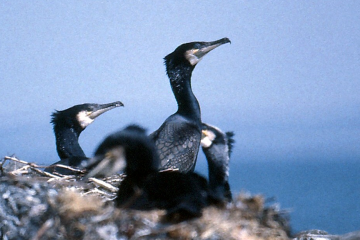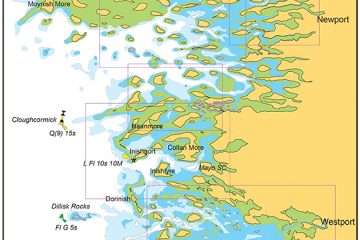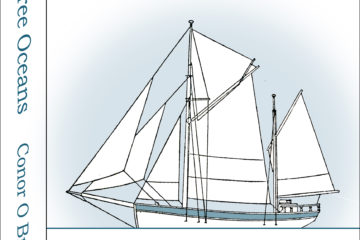By WM Nixon (From Afloat Ireland)
In Ireland, we’re living through the Decade of Centenaries in terms of marking conflict-laden historical events and major national happenings ashore. So it says everything about the blissful sense of having a world of our own in sailing that in 2021 and 2022, Ireland-on-the-water is likewise in the midst of celebrating the Centenary of the establishment of two very significant and thriving boat classes, classes which are in such good heart today that you’d assume they came into being in a time of piping peace and powerful prosperity.
You can say a lot about the tumultuous years of 1921 and 1922 in Ireland. But “piping peace and powerful prosperity” is not a phrase that would spring readily to mind. Yet despite the turmoil of the times with Northern Ireland emerging in 1921 and the Irish Free State being recognised in 1922, in 1921 the new Alfred Mylne-designed Bermuda-rigged sloops of the River Class One-Designs of 28ft 3ins LOA started racing on Belfast Lough. And in 1922, racing started on the great lakes of our longest river for the new una-rigged Shannon One Designs – the Sods, as they immediately and inevitably became known.

Walter Levinge building a Shannon OD on the shores of Lough Ree. In a long association with the class from 1922 onwards, he built sixty of this class in addition to other clinker types such as Water Wags and Mermaids.
Designed by Morgan Giles and built by the best of the local craftsmen, the new 18ft clinker-built boats were a very refined sailing development of the classic Irish lake boat. Racing was mustard-keen from the start, so all construction was of the permitted minimum weight, resulting in a hull which – when hard on the wind in a bit of a breeze – “would turn round and look at
you”.

From the inauguration of the class, it was realised that hull flexibility was an inevitable factor which had to be accommodated in a successful Shannon One Design
RIVER CLASS – WEIGHT IS GREAT…….
The Rivers by contrast are of hefty form, and not afraid of carrying a bit of extra weight. In fact, it’s the contrast which sailing a River provides – when set against the experience of racing an ultra-light turn-on-a-sixpence modern machine – which is a part of the boats’ charm. Though they’re no slouches in terms of speed, things may happen slowly when manoeuvring. But they happen very surely too. Collisions can be epic, so thinking well ahead to the next close interaction with other boats is part of a successful River sailor’s mental makeup.
While it’s believed they were the world’s first Bermuda-rigged One-Design, it’s surprising how little has been made of this – other than by River Class aficionados – either now or at the time of their inception. For when the boats were first being discussed in 1919, the use of Bermuda rig was primarily for its relative ease of handling rather than innovation for its own sake.

A heavy boat which is a One-Design racing success – the 2021 River Class Centenary Regatta Champion Enler (Graham Smyth) chasing Shimna, which has been owned by the Andrews family since 1924. Photo: W M Nixon
Somewhere it is mentioned – though quite where nobody now knows – that when the early discussions were under way about the new class, it was stated that a basic requirement was that the new boat “should be capable of being raced by a man and his daughters”.
Sadly, this is far from being an enlightened early initiative to promote Women on Water. On the contrary, it was an expression of hidden loss. Before World War I broke out in 1914, the northern waters of Ireland were home to several labour-intensive spectacularly rigged boat classes which sported demanding jackyard topsails and the like, boats such as the “old” Belfast Lough No 1s, the new Island Class yawls, a nascent class of International 8 Metres, the Belfast Lough Star Class, and quite a few hard-raced cruiser-racers.

Belfast Lough-style sailing, pre-1914. The Cultra-based cruiser-racer Lily Maid of Royal North of Ireland YC racing in Clyde Fortnight 1910. Photo: Courtesy RNIYC
But with the huge loss of life sustained among the fittest young men in the Great War, the able topsail-setters and spinnaker hands never returned. Or if they did return, it was as disabled ex-servicemen. At its most extreme, it could be argued that that the River Class emerged from the Battle of the Somme. But in fact, although the war ended in 1918, what with the severe post-war economic depression and the ravages of the Spanish flu epidemic, it was 1925 by the time Belfast Lough sailing had returned to anything like its pre-1914 levels in what had been the Golden Age of Yachting.
Thus, the Rivers were probably seen by some as a poor substitute for the spectacular racing yachts of the Golden Age, but they were soon proving themselves very capable craft. Although they had originated in Belfast Lough in the Royal Ulster YC, the wealthy landowners around Strangford Lough were soon snapping them up, such that by the 1930s, every self-respecting big house around Strangford Lough had a River moored at the bottom of the garden.

Saturday afternoon perfection – the century-old River Class racing on Strangford Lough. Photo courtesy River Class
This development – and the many others which saw the class increased to twelve boats all of which took part in the 2021 Centenary – is detailed in its proper context in the excellent Centenary history, The Strangford Lough River Class by James Nixon. And yes, he is the brother, despite which it really is a superb and profusely illustrated book.
You’ll note that they’re now called the Strangford Lough River Class, for since the late 1930s the class’s home has been Strangford Lough YC at Whiterock. Before that, they had that period of being the “boats from the big houses”, the playthings of the rich and powerful. In 1930s Northern Ireland, this meant that while the Ulster Farmers’ Union was “The Unionist Party Up On A Tractor”, the River Class was “The Upper Echelons of the Unionist Party Out In A Boat”.

“Back from the dead”. Kenny Smyth with his restored River Class Laragh in 1990 after she’d spent fifteen years forgotten in a field. Photo: W M Nixon

Round Ireland legend Dickie Gomes at the helm of the River Class Uladh – like many Alfred Mylne designs, the Rivers benefit from keeping crew weight forward. Photo: W M Nixon
Be that as it may, several of the class have come through the inevitable period of being seen as old tore-outs of no further value to become – by some miracle of survival – classics whose intrinsic worth merits restoration. The shipwrights’ skills of the Smyth family of Whiterock Boatyard played a leading role in having these fine boats in peak order for their class’s hundredth birthday in 2021, and Graham Smyth in the immaculate Enler (no 12, originally built 1936) won the Centenary Series in a busy season which involved, as usual, the Rivers’ stately involvement in the rough and tumble of the Narrows Regatta down at Portaferry and Strangford village.
Two boats of very different style
In terms of boat styles and sailing locations, the River Class and the Shannon One Designs could not be more different. And that -added to simple geographical separation – means there are probably very few people who have raced in both. Your columnist makes this point out of total self-interest, as he happens to be one of them, having raced in the Rivers at Whiterock with Brian Law in Uladh to achieve a bullet and a third in evening races, and at Kircubbin Regatta a very very long time ago with the late Jack Andrews in Shimna, when we notched a second.
The Andrews family have owned Shimna since 1924, so this was River Class Immersion Therapy in a big way. But the Shannon One Designs can well match it, as I realised when getting the Royal Command from Alf Delany to join him for two races in the Shannon One Designs Golden Jubilee Regatta at Dromineer in August 1972.
Feeble excuses about knowing nothing whatever about SOD sailing were airily dismissed by the great man – a multiple champion and former Olympian – with the comment that if I proved to be useless at everything else, then I could always be the bailer-hand. That was not encouraging for someone raised in the safety of keelboat culture, but when we started sailing it was hectic from the word go, as the fleet was so large that we seemed to be racing against a new wave of boats with every tack.
And despite having only one sail to set and trim, it was a continuous surprise to learn how much work was required with a crew of three to keep a Shannon One Design at optimum performance, particularly with a neophyte crewman disguising a severe case of imposter syndrome and somehow managing not to be found out, even when asked to take a spell at the helm.

Keeping a Shannon One Design in optimum racing mode is definitely a three-person challenge. Photo courtesy SODA
Fortunately, they were only brief periods of steering, and Alf’s genius ensured that we were in the frame in both races, by which time I was well knackered. Thus, the message is that if you want to experience a totally new kind of sailing without leaving the island, then inveigle your way aboard a SOD. But take care that your initial introduction is for one day only, as you’ll head away from Dromineer or Ballyglass or wherever with aches and bruises in muscles that you didn’t even know existed.
It may at times be torture, but it’s exquisite torture – the Shannon One Designs are so perfectly suited to sailing our larger lakes that they’ve become the very expression of them. And despite the hard-driving they receive, they are built with the sort of loving attention that is reserved for works of art, with the style being set by the first main builder, Walter Levinge of Lough Ree, who started in 1922 and had built sixty SODs by the time of his death, with the mantle being taken up by Jimmy Furey of Lecarrow, who was so much his own man that he was largely self-taught, yet his boats and boat models won awards for creative skill.
The wonder of the Shannon One Designs has been well matched by the colourful characters who sail them. As Class Chairman Philip Mayne and Honorary Secretary Naomi Algeo and their helpers beaver away to put together a manageable Centenary programme even as we wonder just how much of the pandemic will still linger next year to hamper events, we’ll know that in addition to possible difficulties of nationwide health circumstances, they’ll be dealing with a numerous class of such individuality that getting co-ordinated activity is sometimes akin to herding cats at a cross-roads.

Shannon OD Hon. Sec Naomi Algeo with her father, longtime SOD sailor and former Lough Ree YC Commodore Alan.
That said, they’ll be celebrating the Centenary of a class which was brought into being despite the country being in general turmoil. Apparently a face-to-face meeting was required of the Steering Committee in 1922 to finalise rules, and two lakeside members decided the safest way to get to it was aboard a motor-launch belonging to one of them. Being proper yotties, they put on proper yachting caps. Big mistake. The word spread along the lake shore like wildfire that an organized uniformed waterborne military patrol of hostile intent was clearly on the move. Somehow it was all calmed down, but according to one report, lead flew before peace broke out.

“Like herding cats at a crossroads” – during a semi-formal visit to Lough Derg YC, former Lough Ree YC Commodore Alan Algeo decided that some water-skiing would be appropriate.


